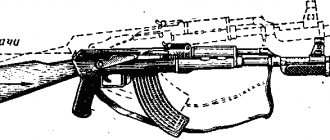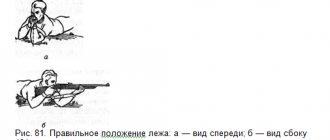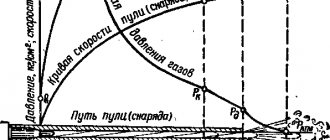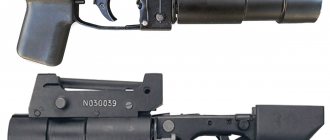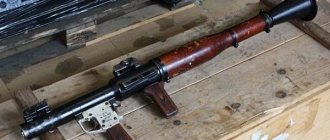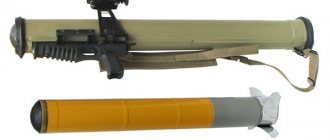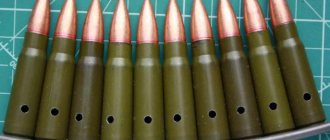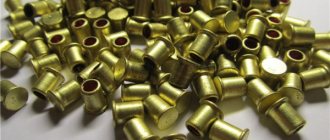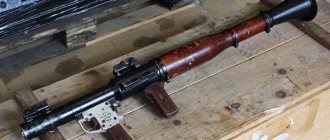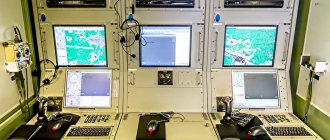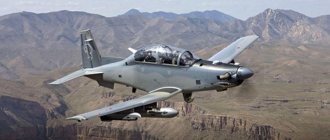Direct shot, its practical application in combat. Covered, target and dead space
The flatness of the trajectory affects the range of the direct shot, the target, covered and dead space
A shot in which the trajectory does not rise above the aiming line above the target throughout its entire length is called a direct shot.
Direct shot
Within the range of a direct shot, during tense moments of battle, shooting can be carried out without rearranging the sight, while the vertical aiming point is usually selected at the lower edge of the target.
The range of a direct shot depends on the height of the target and the flatness of the trajectory. The higher the target and the flatter the trajectory, the greater the range of a direct shot and the greater the area over which the target can be hit with one sight setting.
The direct shot range can be determined from tables by comparing the target height with the values of the greatest elevation of the trajectory above the aiming line or with the trajectory height.
When shooting at targets located at a distance greater than the direct shot range, the trajectory near its top rises above the target and the target in some area will not be hit with the same sight setting. However, there will be a space (distance) near the target at which the trajectory does not rise above the target and the target will be hit by it.
The distance on the ground over which the downward branch of the trajectory does not exceed the height of the target is called the affected space (the depth of the affected space).
The depth of the affected space depends on the height of the target (it will be greater, the higher the target), on the flatness of the trajectory (it will be greater, the flatter the trajectory) and on the angle of inclination of the terrain (on the forward slope it decreases, on the reverse slope it increases).
Dependence of the depth of the affected space on the height of the target and the flatness of the trajectory (angle of incidence)
In the case where the target is located on a slope or there is an elevation angle of the target, the depth of the affected space is determined using the above methods, and the result obtained must be multiplied by the ratio of the angle of incidence to the angle of encounter.
The magnitude of the meeting angle depends on the direction of the slope: on the opposite slope, the meeting angle is equal to the sum of the angles of incidence and slope, on the reverse slope - the difference between these angles. In this case, the magnitude of the meeting angle also depends on the target elevation angle: with a negative target elevation angle, the meeting angle increases by the value of the target elevation angle, with a positive target elevation angle, it decreases by its value.
The target space to some extent compensates for errors made when choosing a sight, and allows you to round up the measured distance to the target.
To increase the depth of the affected area on sloping terrain, the firing position must be chosen so that the terrain at the enemy’s location, if possible, coincides with the extension of the aiming line.
The space behind cover that cannot be penetrated by a bullet, from its crest to the meeting point, is called covered space. The greater the height of the shelter and the flatter the trajectory, the greater the covered space
The part of the covered space in which the target cannot be hit with a given trajectory is called dead (unhittable) space. The greater the height of the cover, the lower the height of the target and the flatter the trajectory, the greater the dead space . The other part of the covered space in which the target can be hit is the target space.
Covered, dead and target space
The depth of the covered space can be determined from tables of the excess of trajectories above the line of sight. By selection, an excess is found that corresponds to the height of the shelter and the distance to it. After finding the excess, the corresponding sight setting and firing range are determined. The difference between a certain firing range and the distance to cover represents the depth of the covered space.
The depth of the dead space is equal to the difference between the covered and affected space.
From machine guns on machine guns, the depth of the covered space can be determined by the aiming angles. To do this, you need to install a sight corresponding to the distance to the cover, and aim the machine gun at the crest of the cover. After this, without disrupting the machine gun's aim, aim under the base of the shelter. The difference between these sights, expressed in meters, is the depth of the covered space. It is assumed that the terrain behind the cover is a continuation of the aiming line directed under the base of the cover.
Knowing the size of covered and dead space allows you to correctly use shelters to protect against enemy fire, as well as take measures to reduce dead spaces by correctly choosing firing positions and firing at targets from weapons with a more forward trajectory.
Tags: fire training
Direct shot
1. Everyday understanding of the term “direct shot”: the bullet flies parallel to the aiming line. The distance of such a shot is 70–80 meters.
2. “Hunting direct shot”: the target size is small (small killing zone, not the whole body), so its distance is only 230 meters.
3. "Army Direct Shot": The target height is 1.6 meters, so its distance is about 400 meters.
Although this parameter is not difficult to understand, for some reason it causes confusion even among experienced shooters. This is due to the fact that everyone understands it differently.
Even for such a powerful cartridge as 7.62x53, it is only 70–80 m. After this distance, the bullet trajectory noticeably decreases, and it is no longer possible to talk about a “classic” direct shot. The distance of a direct shot directly depends on the initial speed of the bullet: the higher it is, the “flatter” the trajectory and the greater the magnitude of the direct shot.
These examples clearly show where the confusion arises. For the same cartridge we got three different direct shot distances. In the first case it is 80 m, for a military shot it is 400 m, and for a hunting shot it is 230 m.
Understanding these features will save the shooter from confusion and mistakes when shooting while hunting.
In conclusion, I would like to note that the main thing for good shooting is practice, shoot more, practice and have fun.
Source
Direct shot range is what?
Information from external ballistics
Having flown out of the bore under the influence of powder gases, the bullet (grenade) moves by inertia. A grenade with a jet engine moves by inertia after the gases flow out of the jet engine.
Trajectory and its elements
A trajectory is a curved line described by the center of gravity of a bullet in flight.
When flying in the air, a bullet is subject to two forces: gravity and air resistance.
The force of gravity causes the bullet to gradually lower, and the force of air resistance continuously slows down the movement of the bullet and tends to knock it over.
As a result of the action of these forces, the speed of the bullet gradually decreases, and its trajectory is shaped like an unevenly curved curved line.
Center of the muzzle of the barrel
The departure point is the beginning of the trajectory
Horizontal plane passing through the departure point
3. Elevation line
A straight line that is a continuation of the axis of the barrel of the aimed weapon
The angle between the elevation line and the horizon of the weapon
If this angle is negative, then it is called the declination (decrease) angle
Straight, a line that is a continuation of the axis of the bore at the moment the bullet leaves
The angle between the throwing line and the horizon of the weapon
The angle between the elevation line and the throwing line
The point of intersection of the trajectory with the horizon of the weapon
The angle between the tangent to the trajectory at the point of impact and the horizon of the weapon
10. Full horizontal range
Distance from departure point to impact point
11. Top of the trajectory
Highest point of the trajectory
12. Trajectory height
Shortest distance from the top of the trajectory to the horizon of the weapon
13. Exceeding the trajectory above the aiming line
The shortest distance from any point on the trajectory to the aiming line
14. Target elevation angle
The angle between the line of sight and the horizon of the weapon
The point of intersection of the trajectory with the target surface (ground, obstacles)
17. Aiming point (aiming)
The point on or off the target at which the weapon is aimed
The angle between the tangent to the trajectory and the tangent to the surface of the target (ground, obstacle) at the meeting point
The meeting angle is taken to be the smaller of the adjacent angles, measured from 0 to 90°
19. Line of sight
A straight line running from the shooter's eye through the middle of the sight slot (level with its edges) and the top of the front sight to the aiming point
20. Sighting range
Distance from the departure point to the intersection of the trajectory with the aiming line
21. Aiming angle
The angle between the elevation line and the aiming line
Giving the bore axis the required position in the vertical plane
Part of the trajectory from the departure point to the top
Giving the bore axis the required position in the horizontal plane
Straight line connecting the departure point to the target
When firing direct fire, the target line practically coincides with the aiming line
Distance from departure point to target along target line
When firing direct fire, the slant range practically coincides with the target range.
Part of the trajectory from the top to the point of fall
Bullet speed at impact point
Vertical plane passing through the elevation line
Total flight time
Time of movement of a bullet from the point of departure to the point of impact
In order for the bullet to reach the target and hit it or the desired point on it
A straight line connecting the middle of the sight slot to the top of the front sight
A direct shot is a shot in which the trajectory of the bullet does not rise above the aiming line above the target along its entire length. The range of a direct shot depends on the height of the target and the flatness of the trajectory. The higher the target and the flatter the trajectory, the greater the direct shot range and, therefore, the distance at which the target can be hit with one sight setting.
The practical significance of a direct shot is that in tense moments of battle, shooting can be carried out without rearranging the sight, while the aiming point in height will be chosen along the lower edge of the target.
The direct shot range can be determined from tables by comparing the target height with the values of the greatest elevation above the aiming line or with the trajectory height.
Straight shot and rounded straight shot ranges
When firing, you need to know that the distance on the ground, over which the downward branch of the trajectory does not exceed the height of the target, is called the target space (the depth of the target space Ppr.).
Depth (Ppr.) depends:
on the height of the target (the higher the target, the higher it will be);
on the flatness of the trajectory (the flatter the trajectory, the greater it will be);
on the angle of inclination of the terrain (on the front slope it decreases, on the reverse slope it increases).
The part of the covered space in which the target cannot be hit with a given trajectory is called dead (unhittable) space. The greater the height of the cover, the lower the height of the target and the flatter the trajectory, the greater the dead space. The other part of the covered space (Sp), in which the target can be hit, is the target space.
The depth of dead space (Mpr.) is equal to the difference between the covered and affected space:
Normal (tabular) shooting conditions
The tabulated trajectory data corresponds to normal shooting conditions.
The following are accepted as normal (tabular) conditions:
· relative air humidity 50% (relative humidity is the ratio of the amount of water vapor contained in the air to the largest amount of water vapor that can be contained in the air at a given temperature);
· there is no wind (the atmosphere is motionless).
· bullet weight, initial speed and departure angle are equal to the values indicated in the shooting tables;
· charge temperature +15°С;
· the shape of the bullet corresponds to the established drawing;
· the heights (divisions) of the sight correspond to the table aiming angles.
· the target is on the horizon of the weapon;
If shooting conditions deviate from normal, it may be necessary to determine and take into account corrections for the firing range and direction.
The influence of external factors on the flight of a bullet
As atmospheric pressure increases, air density increases, and as a result, the force of air resistance increases and the bullet's flight range decreases. On the contrary, with a decrease in atmospheric pressure, the density and force of air resistance decrease, and the bullet’s flight range increases.
As the temperature rises, the air density decreases, and as a result, the force of air resistance decreases and the bullet's flight range increases. On the contrary, as the temperature decreases, the density and force of air resistance increase, and the bullet’s flight range decreases.
With a tailwind, the speed of the bullet relative to the air decreases. As the speed of the bullet relative to the air decreases, the force of air resistance decreases. Therefore, with a tailwind, the bullet will fly further than with no wind.
In a headwind, the speed of the bullet relative to the air will be greater than in a calm environment, therefore, the force of air resistance will increase and the bullet's flight range will decrease.
Wind speed is determined with sufficient accuracy by simple signs: in a weak wind (2-3 m/sec), the handkerchief and flag sway and flutter slightly; in moderate winds (4-6 m/sec), the flag is kept unfurled and the scarf flutters; in a strong wind (8-12 m/sec), the flag flutters noisily, the scarf is torn from the hands, etc.
Changes in air humidity have a negligible effect on air density and, therefore, on the range of a bullet, so it is not taken into account when shooting.
Penetrating (killing) effect of a bullet
For firing from a machine gun, cartridges with ordinary (steel core) and tracer bullets are used. The lethality of a bullet and its penetrating effect mainly depends on the range to the target and the speed that the bullet will have at the moment it meets the target.
Firing range, m.
% through penetration or bullet penetration depth
Steel sheets (at a meeting angle of 90°) thickness:
Source
Just a quick glance at external ballistics.
In reviews of previous issues of our almanac, comrades note that, they say, there is too much theory and not enough real-life examples. I'll listen.
That's it, end of the theoretical part.
The practice that follows from this, however, is far from being as simple as it might seem at first.
For the [second, distant zero] zero, a distance of 100m is usually selected. As we will see in the next issues of our almanac, the influence of atmospheric conditions at this distance is still very small, but at the same time it is already easy to determine the average point of impact with sufficient accuracy.
So far we have looked at the sight of a normal person. Consider the giraffe smoker's scope.
Attention, question: what should Guna do with the old ballistic tables, in the compilation and verification of which a lot of time and ammunition was invested.
Attention, answer: when zeroing a new scope at the same distance as the old one, the average point of impact will shift exactly by the difference in the height of the aiming line. In our case, the STP will be 1 cm higher. Since Gunya is not his own enemy, his tuning drums are graduated in milliradians. With a click price of 0.1 mrad, and zeroing at 100m, the difference in the aiming angle will be 1cm per 100m = 1 click. Total: compared to the old sight, at all distances you will need to adjust one click less than what is written in the old ballistic tables (or after zeroing, scroll down one click and use the old tables as is) [1].
The issue with the ballistic tables was successfully resolved, Gunya rejoiced at the marvelous new sight, as he had last rejoiced at his own bicycle in childhood, but the matter did not end there. For a comfortable insert with the new mounting height, I had to make a cheek piece on the butt. Cursing his own laziness and inattention in long-forgotten school labor lessons, Gunya consoled himself with the thought, I quote, “but now, with a high sight, the direct shot range (DPV) will increase,” because he read such a statement on some forum on the Internet.
A clear example will help us understand how everything will work out with consolation, and what it’s all about. In his leisure hours, sniper Gunya hunts for Hell's Teletubbies. Dimensional drawing of Hell's Teletubby is attached:
The attentive reader will note that the DPV also depends on the shooting distance. As a rule, when they talk about the DPV “in general,” they mean the maximum DPV, that is, with a zero shooting distance at which the peak height of the trajectory exactly corresponds to the upper edge of the target. In our case, such a zero is located at 434 m, and a direct shot at a meter target is possible up to 511 m:
Aiming at the center, target height 30 cm:
Aiming “under the bleed” (at the waist), target height 50 cm:
For comparison, with a normal sighting at 100m, for a target with a height of 20cm, the DPV would be 197m; at the cost of a few clicks of the sight you can buy 278-197=81 meters of carefreeness.
For example, for the above-mentioned Tigor with the Barnaul cartridge [8], for a target 20 cm high, at different firing distances the dangerous zones look like this:
In other words, the conclusion is: the greater the shooting distance, the more accurately you need to know it.
and at medium and long distances
At some point, the trajectory of a heavy bullet becomes flatter than a light one, and catches up and surpasses it in height, see the point of intersection of the graphs.
Nota bene: here and below, bullets of similar design and shape are compared, otherwise you can start comparing a variety of more or less aerodynamic projectiles, and with the same bullet mass and muzzle velocity, get any results you want, proving that it hit anywhere.
As expected, at close ranges the lighter bullet has a flatter trajectory.
Conclusions: (valid for bullets of similar design and shape, in the same caliber, with correctly selected powder weights)
[4] 2½-3 cm approximately corresponds to the difference in height between the “native” AKMoid sighting devices and optics on a high crown, or the whole thing and SVD optics.
[6] According to the manufacturer. I would double-check just in case (see previous issues of our almanac).
[9] This is especially true for Internet shooters.
[12] 155gr BTHP Match vs 178gr BTHP Match
[13] Hunting SPCE 9.7 g / BC G1 0.280 / 850 m/s vs. SPCE 11.7 g / BC G1 0.316 / 765 m/s
[14] Since the invention of ballistics calculators, satisfying ballistics curiosity is much less expensive than in the old days. In addition, there is no danger of running into trouble with hunting authorities due to the use of 50-gram armor-piercing incendiary bullets of 12.7mm caliber against rare species of Hellish Teletubbies.
Source
